The North Sea Coast
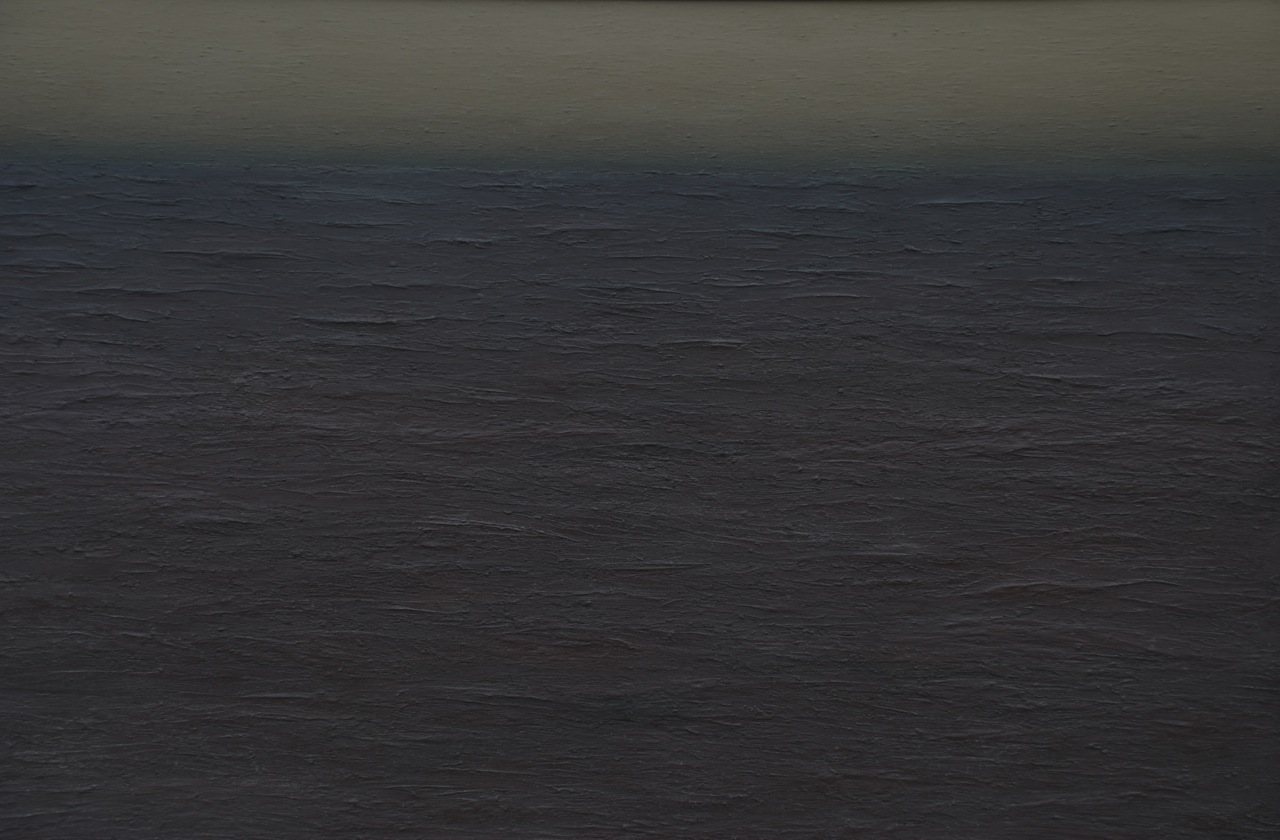
Dark Sea. Oil on canvas, 48 x 72 in. (1220 x 1829 mm.)
The formal embodiment of mood remains an important aspiration.
The mood of a landscape appears to us to be objectively given with it as one of its attributes, belonging to it just like any other attribute we perceive it to have. … We never think of regarding the landscape as a sentient being whose outward aspect ‘expresses’ the mood that it contains subjectively. The landscape does not express the mood, but has it; the mood surrounds, fills and permeates it, like the light that illumines it, or the door it exhales; the mood belongs to our total expression of the landscape and can only be distinguished as one of its components by a process of abstraction. (Otto Baensch in Langer [1953] 1963: 19)
Immensity is within ourselves. It is attached to a sort of expansion of being that life curbs and caution arrests, but which starts again when we are alone. ... Indeed, immensity is the movement of motionless man. (Bachelard [1958] 1964: 184)
To disappear into deep water or to disappear toward a far horizon, to become a part of depth or infinity, such is the destiny of man that finds its image in the density of water. (Bachelard [1942] 1994: 12)
The integration of subjectivity and spatial, material environment leads ultimately, In my view, to a larger significance:
With the rise of perspective, then, the deeper form and full metaphysical significance of the picture comes to be concentrated upon the horizon. (Spengler 1961, I: 242)
The poetic imagination for Gaston Bachelard manifests a fundamental identification of sensibility with elemental, all pervasive matter. Thales of Miletus (c. 585 BC), accounted the first philosopher in the Western tradition, proposed that there is one fundamental substance from which all others are formed, and this is water. He thus manifested the fundamental motivation to find unity in diversity that is so profoundly important for both physical science and aesthetics.
The painting Dark Sea was the last in a series that I made dealing with views straight out to sea. I had made numerous watercolour studies, in this instance from the crumbling cliffs at Dunwich in Suffolk, where the sea has claimed almost an entire medieval village. I was particularly impressed by the broad, expansive monotony of the North Sea and its unbroken horizon. The aim with the painting was to achieve an elemental integration of matter, space and feeling.
A Post - Human Landscape
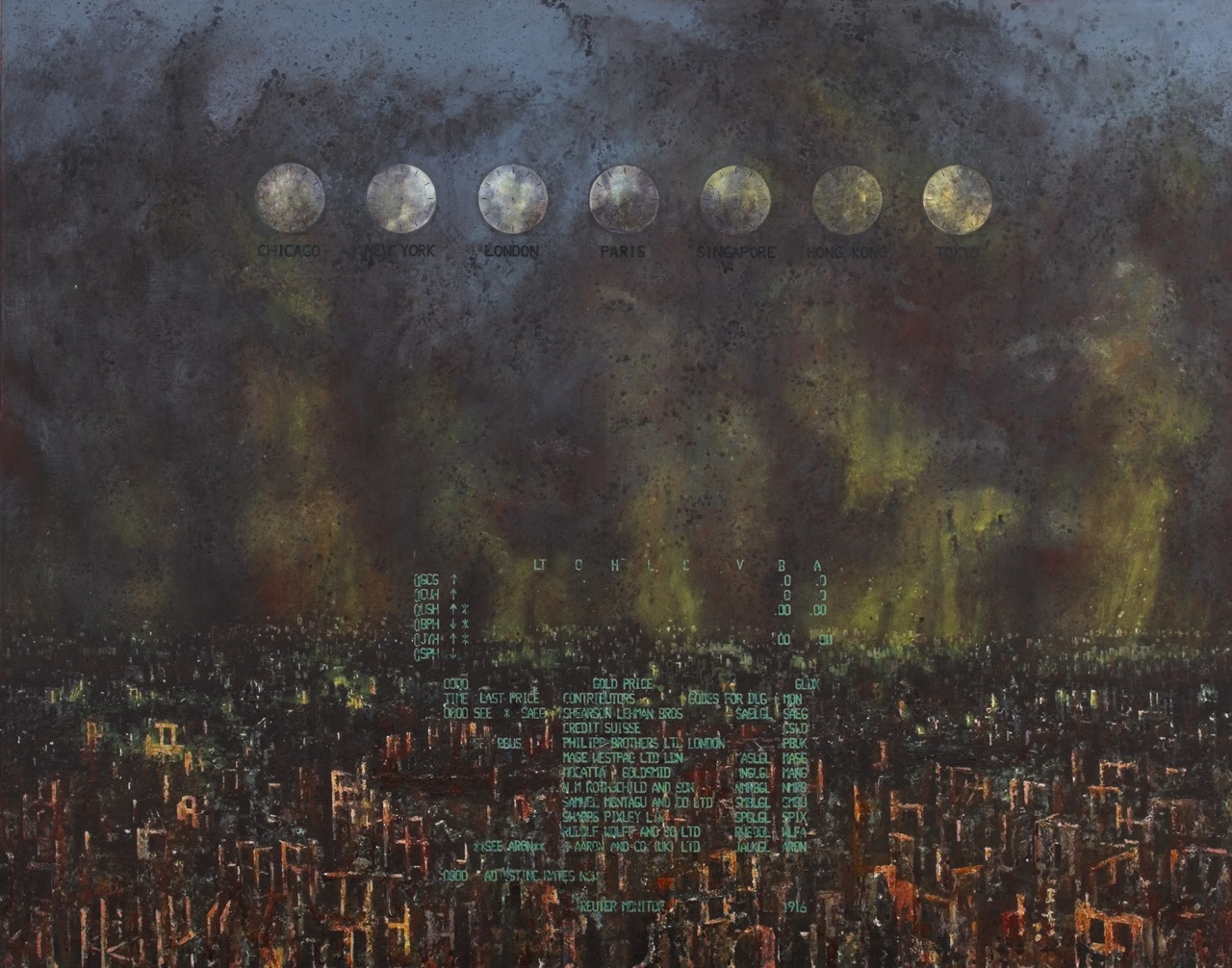
The Price of Gold. Oil on canvas, 84 x 66 in. (2134 x 1680 mm.)
The Price of Gold resulted from visiting a purchaser for one of my paintings in the summer of 1986. He was a fund manager at the World Trade Centre in London, I met him on a floor of computers. My patron invested heavily in gold, he was anticipating an eventual destabilisation in global money markets with a consequent rise in gold prices, all of this to be accompanied by devastating social and political turmoil. When I visited however the gold price was plummeting, catastrophe seemed to be in the air. Clocks showing the time in stock exchanges around the world were set in a line along one wall, I included them in my painting, but without hands.
 copy.jpg?timestamp=1462186446592)
The School of Athens (after Raphael). Oil on canvas, 84 x 84 in. (2134 x 2134 mm.)
The School of Athens (After Raphael) was partly and ironically suggested by the sight of people living under the roundabout and railway arches between Waterloo Station and Waterloo Bridge during the economic recession of the1980s, humanist culture subverted by its opposite.
Snowdonia
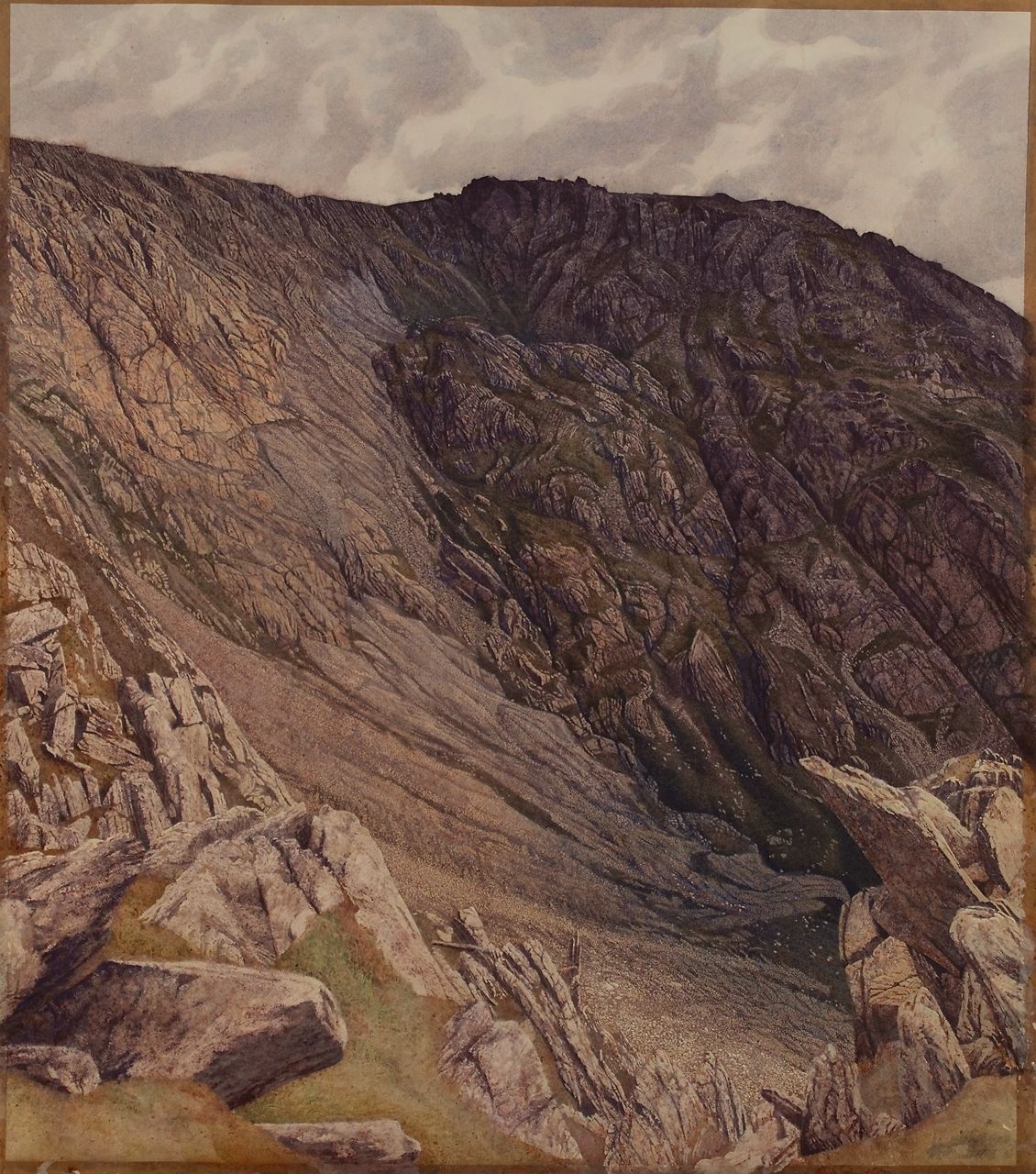
Lines of Force: Cwm Cneifion. Watercolour and gouache on paper, 45 x 39 in. (1143 x 991 mm.) Private collection.

Bones of the Land: Nant Ffrancon. Watercolour and gouache on paper, 30 x 43 in. (762 x 1,092 mm.)
(Private collection).
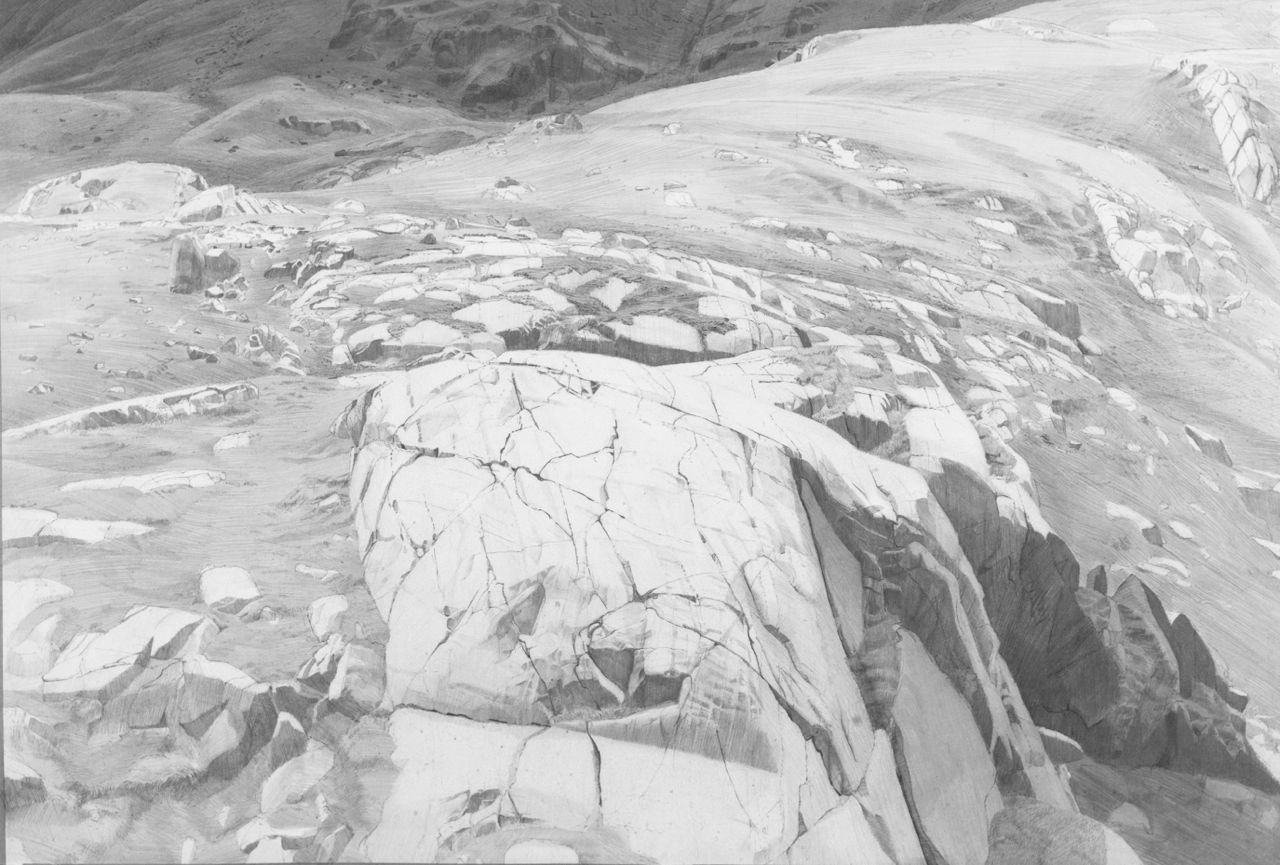
Glaciated Rocks: Pen y Benglog I. Graphite and watercolour on paper, 20 x 28 in. (508 x 711 mm.)
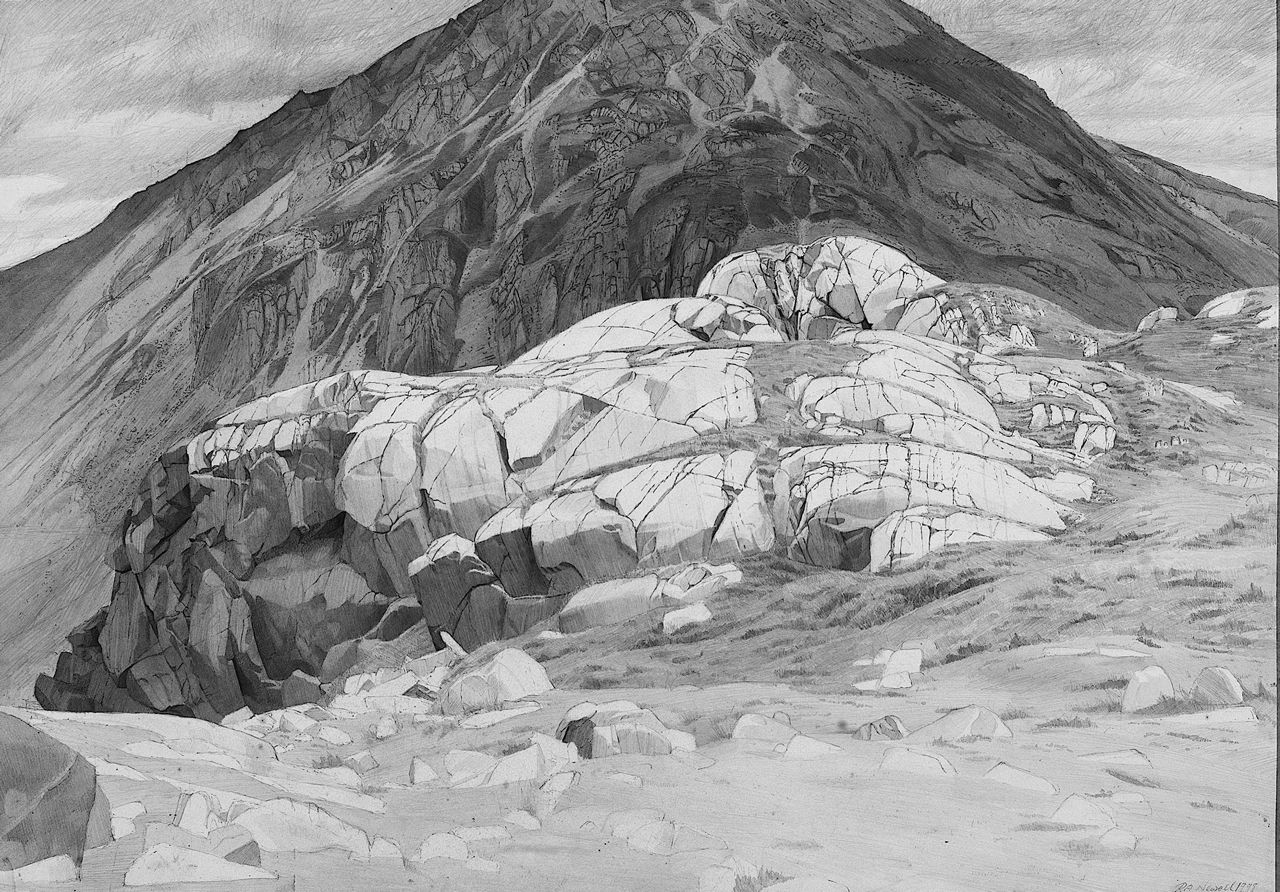
Glaciated Rocks: Pen y Benglog: II. Graphite and watercolour on paper, 20 x 28 in. (508 x 711 mm.)
One winter I came across an outcrop of rounded glaciated rocks above Nant Ffrancon on Pen y Benglog (Summit of the Skull) that I recognised as those drawn by John Piper in c. 1946-8: Glaciated Rocks, Nant Ffrancon (Tate Britain). Eventually, with a bit of searching, I found the very same viewpoint. The geological term for rocks of this type: roches moutonnees, reflects the similarity of these rounded forms to recumbent sheep.
 Robert A. Newell Glaciated Rocks - Pen y Benglog III 508 x 711 mm. 1993 Graphite pencil and watercolour on paper.jpg?timestamp=1462190970625)
Glaciated Rocks: Pen y Benglog III. Graphite and pencil on paper, 20 x 28 in. (508 x 711 mm.)
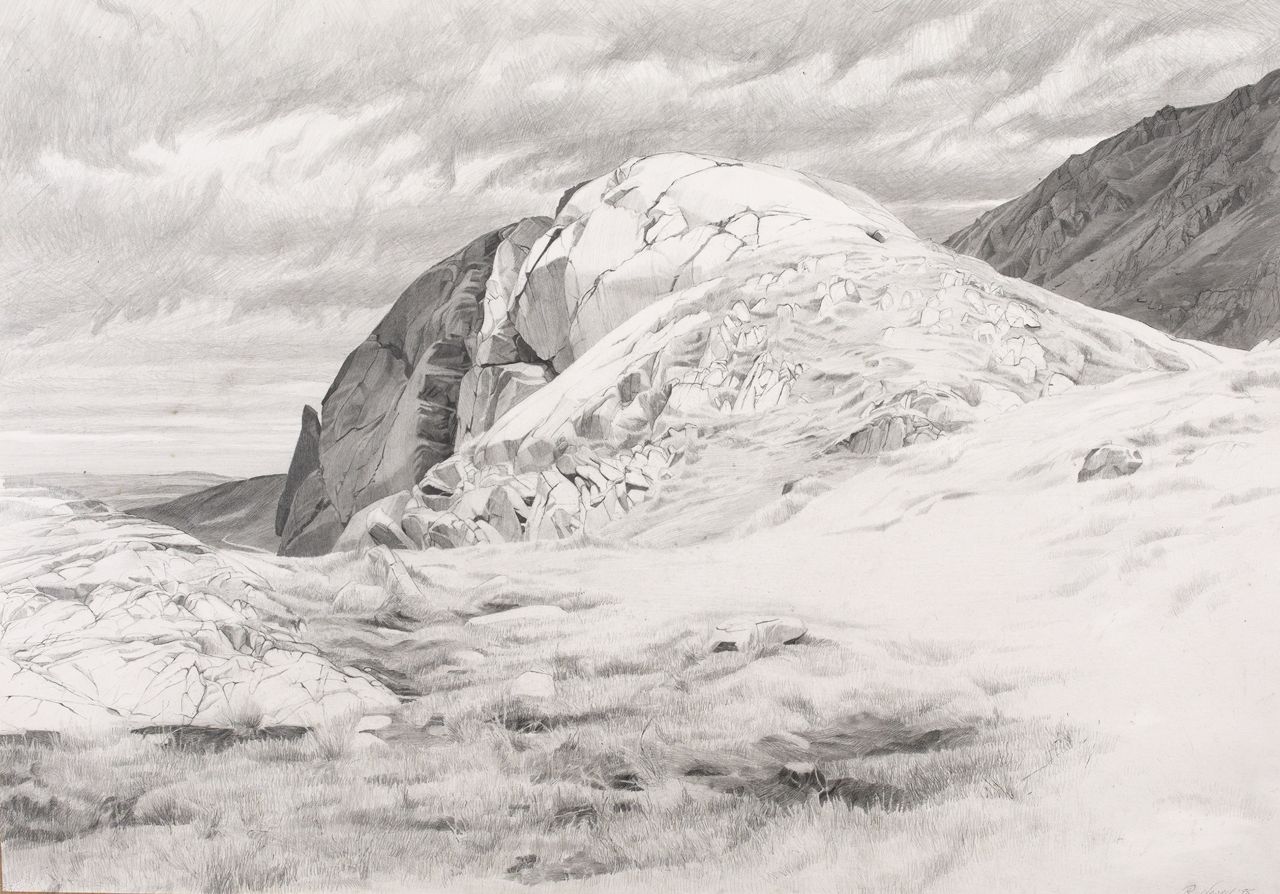
Glaciated Rocks IV. Graphite and pencil on paper, 20 x 28 in. (508 x 711 mm.)
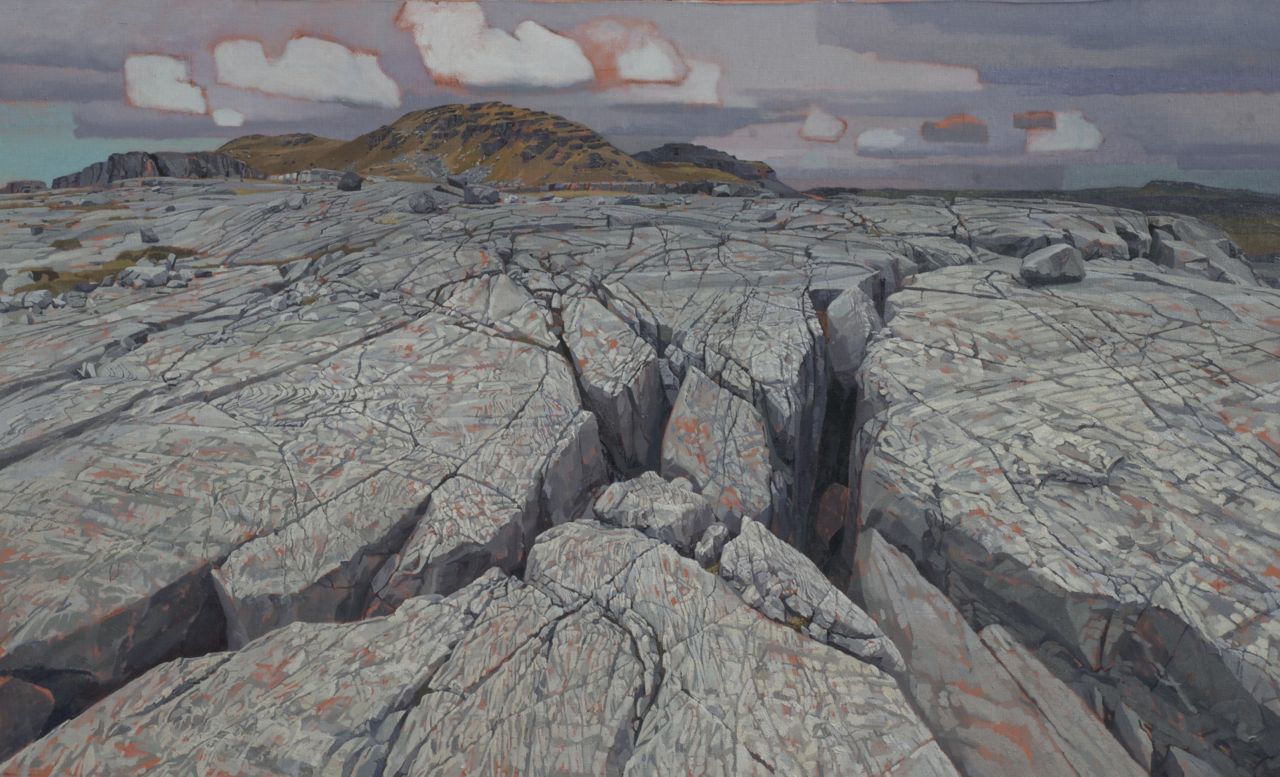
Harlech Grits: Towards Moel Ysgyfarnogod. Oil on canvas, 37 x 60 in. (940 x 1525 mm.)
The oldest rocks in Snowdonia. The Cambrian greywacks, a course grained sandstone, formed some five hundred million years ago.
Harlech Grits: Towards Moel Ysgyfarnogod. Pencil and watercolour on paper, 21 1/2 x 35 1/2 in. (545 x 902 mm.)
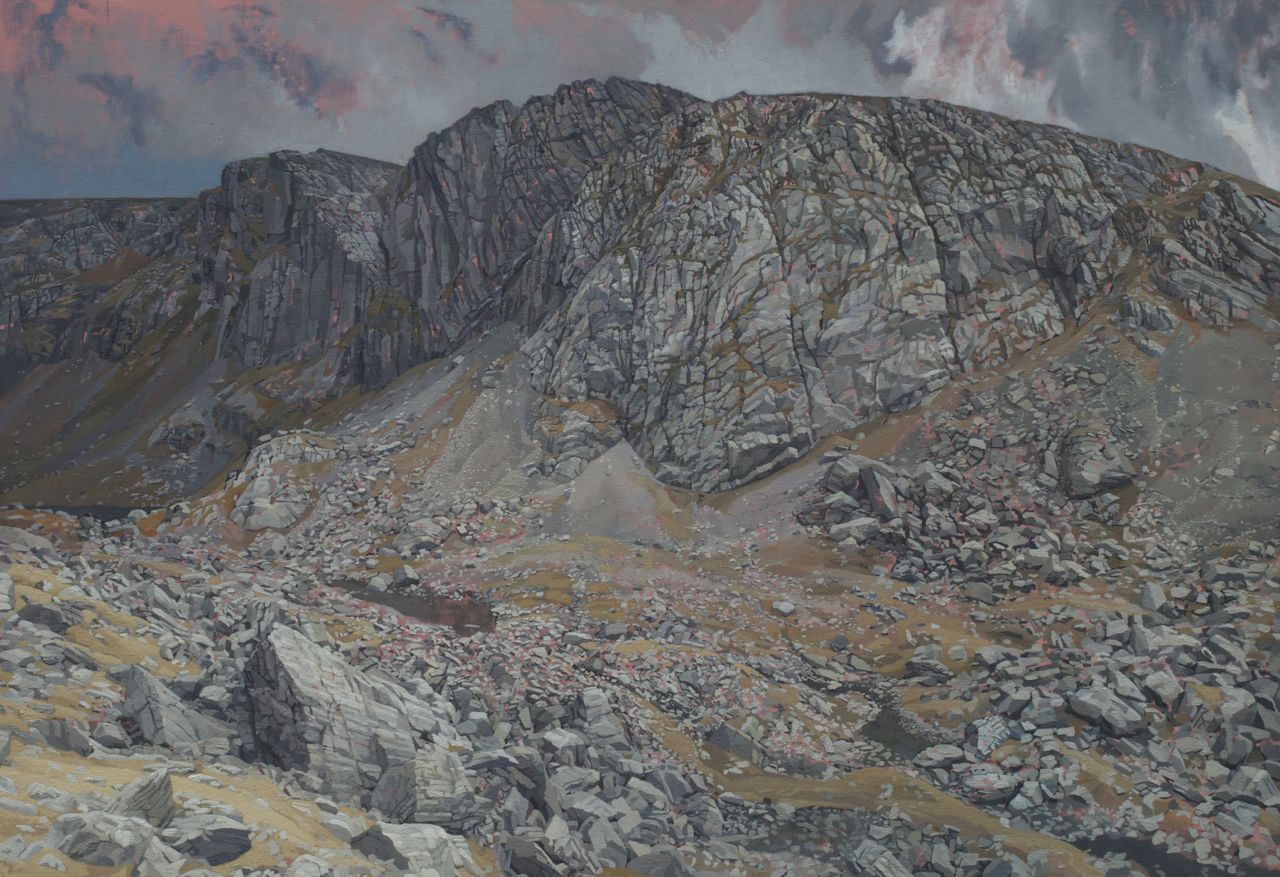
Clogwyn Du’r Arddu. Oil on canvas, 42 x 60 ins. (1067 x 1525 mm.)
Clogwyn Du’r Arddu is a volcanic formation created over some 4 to 5 hundred million years ago. Its successive beds rise above screes and boulders that exhibit the meeting of chaotic randomness with the interrupted rhythms and order of gravitational flows punctuated by erratics distributed by a glacier that vanished some 10,000 years ago.
Brecon Beacons
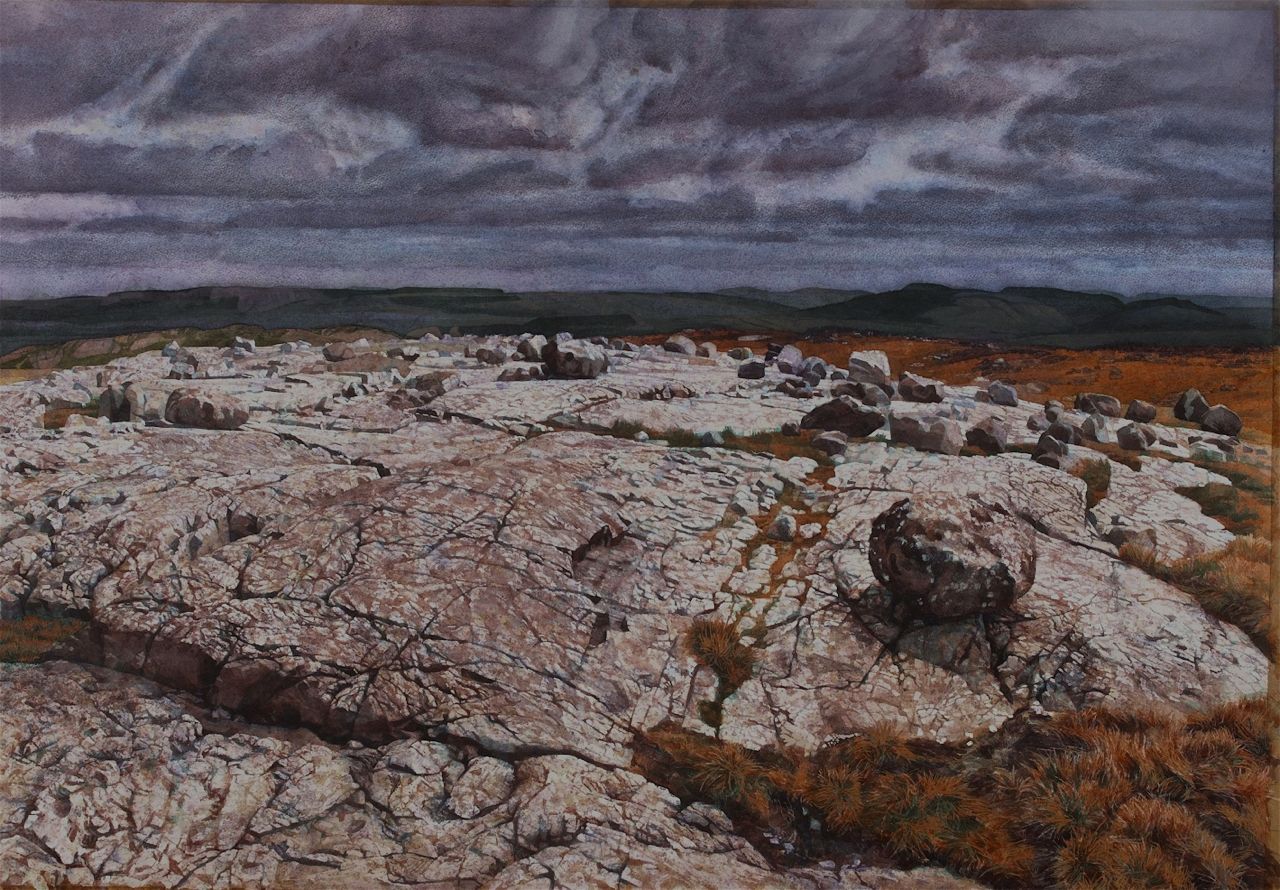
Crystalline Expanse: Carreg Goch. Watercolour and gouache on paper, 33 x 43 in. (838 x 1092 mm.)
(Private collection).

Prospect and Refuge: Towards Carreg Goch. Watercolour and gouache on paper, 32 x 43 in. (813 x 1092 mm.) (Private collection).
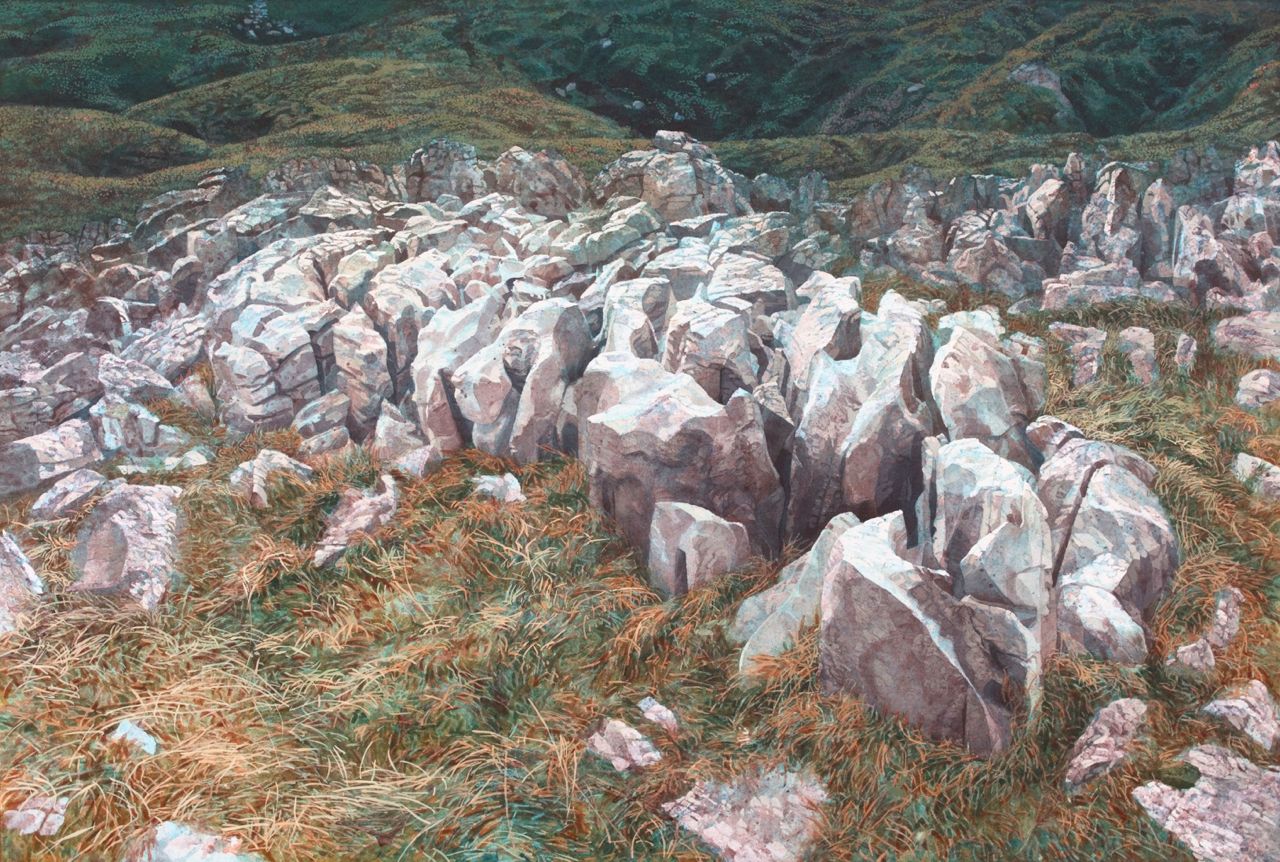
Limestone Anatomy: Twyn Du. Watercolour and gouache on paper, 29 1⁄2 x 44 in. (749 x 1118 mm.)
(Brecknock Museum and Art Gallery).
Twyn Du is a summit of limestone outcrops. The clints are particularly fine and intricate in form, creating ridges, spurs and points with edges that subtly modulate, often becoming razor sharp. In places, sequences of clints produce vertebra like configurations suggestive of half buried skeletal remains of fantastic extinct animals; jaws gape from the ground, claws clutch at the air. There is a continual interplay between order and chaos as patterns of clints and grikes are lost in profusions of scattered and heaped fragments, shattered by frost and the ravages of time. The expanse of weathered limestone produces intricate sequential patterns and groupings of stones along their characteristic jointing; these are separated visually by areas of grass and peat. In addition there are confused profusions of scattered and heaped fragments of stones that have long ago broken down from their original formations. Seen from certain positions and in certain lights, entirely spontaneously, gestalts or figures may be apparent in which ordered shapes and patterns emerge from areas of the chaotic ground of broken stones. Moreover these ordered shapes are rendered all the more noticeable and memorable by their resemblance to skeletal structures. The visual experience of the stones combined with the idea of vertebrate anatomy, so that I experienced the dawning of a skeletal aspect whose appropriateness to the configuration of stones was such that the visual perception was transformed by the anatomical conception. Graham Sutherland made paintings and drawings of trees and fallen branches in ways that created an animated, anthropomorphic expressiveness:
It is not a question so much of a ‘tree like a figure’ or a root like a figure - it is a question of bringing out the anonymous personality of these things; at the same time they must bear the mould of their ancestry. There is a duality: they can be themselves and something else at the same time. They are formal metaphors (Sutherland in Yorke 1988: 119)
This can be related to Rudolph Arnheim’s discussions of “nonhuman expression” (Arnheim 1966b: 64). Arnheim argues that such expression is a fundamental component in perception rather than simply being anthropocentric pathetic fallacy. Seen in this way, “Expression, then, would be defined as the psychological counterpart of the dynamic processes that result in the organization of perceptual stimuli.” (Arnheim 1966b: 62)
Gower Coast
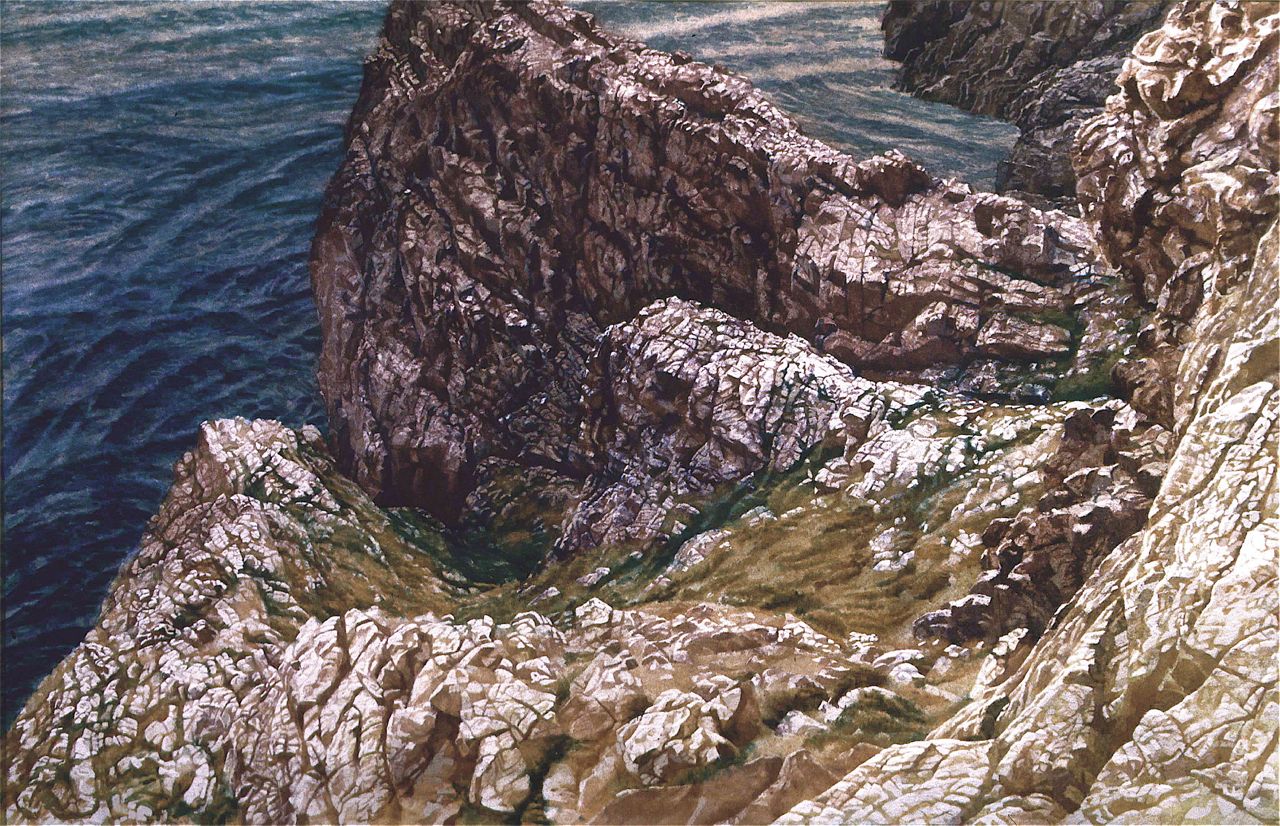
Limestone: Gower. Watercolour and gouache on paper, 30 x 43 in. (762 x 1092 mm.) (Private collection).
Angelsey Coast
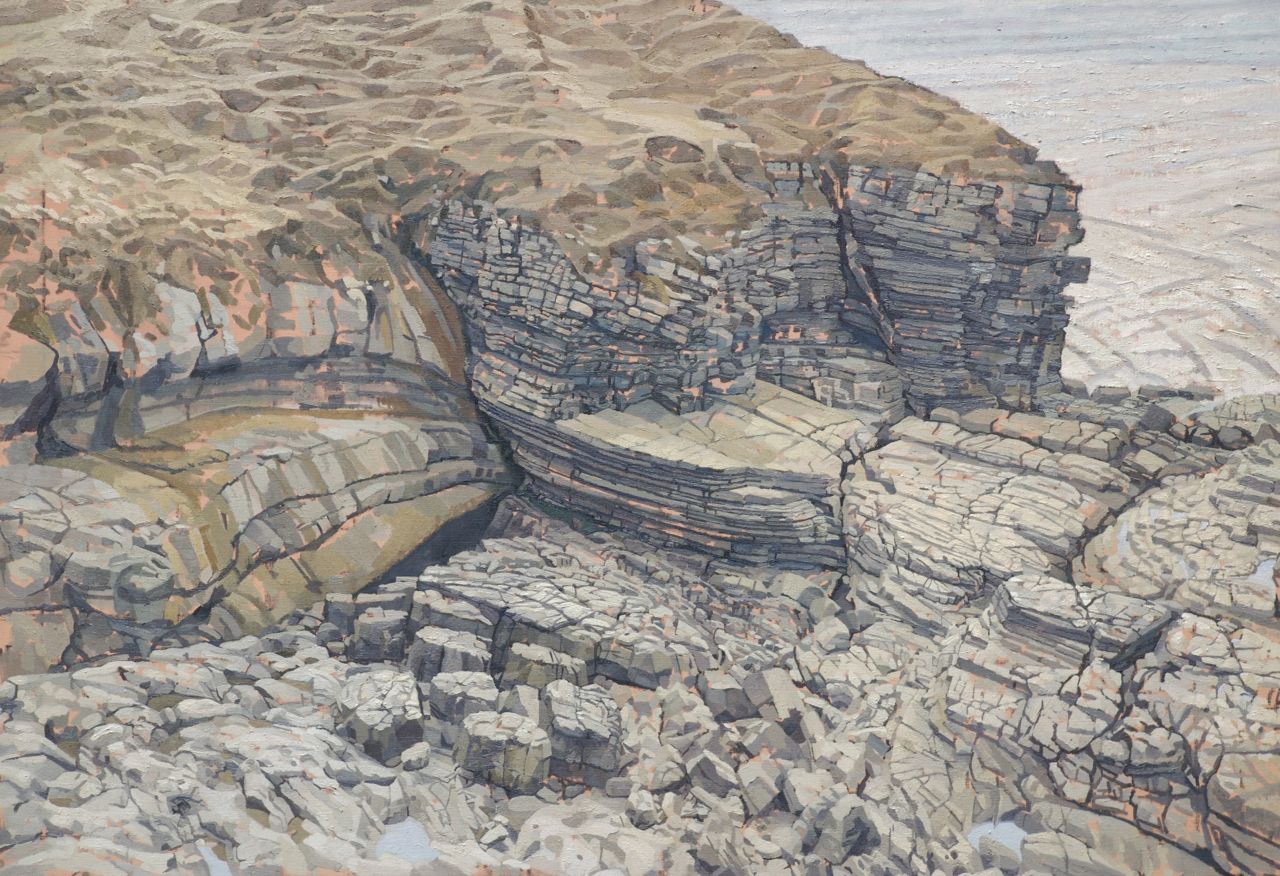
Limestone Cliffs: Caim. Oil on canvas, 33 1/2 x 48 in. (850 x 1220 mm.)
.jpg?timestamp=1462193352258)
Limestone Cliffs: Caim. Pencil and watercolour on paper, 21 x 29 in. (533 x 736 mm.)
… Any line drawn on a sheet of paper, …, is like a rock thrown into a pond. It upsets repose, it mobilizes space.”(Arnheim A & VP [1954] 1974: 16)
For drawing, a blank white sheet of paper is a field of potentiality. Rudolph Arnheim describes how the picture plane, even when blank, by virtue of its inherent topography of sides, corners and centre, is a “field of perceptual forces”. Shapes or marks placed on the picture plane are immediately in tension with the topography of the plane itself. So what is the status of space? Is it physical? Is it mental? Is it spiritual? As a drawing or painting proceeds, space is made apparent; its scale, depth and character emerge in often surprising ways. This space is experienced as an inner sensation, unique to the place; as sensation, it is embodied, aesthetic, rather than an abstract idea. Drawing makes space apparent within a complexity of relations and potentialities that often cannot at first all be seen or comprehended, this is fundamentally temporal, a synthesis of perceptual events, a process of constructive revelation. Every touch, detail and relation is a materialised thought.
Cumbria Limestone
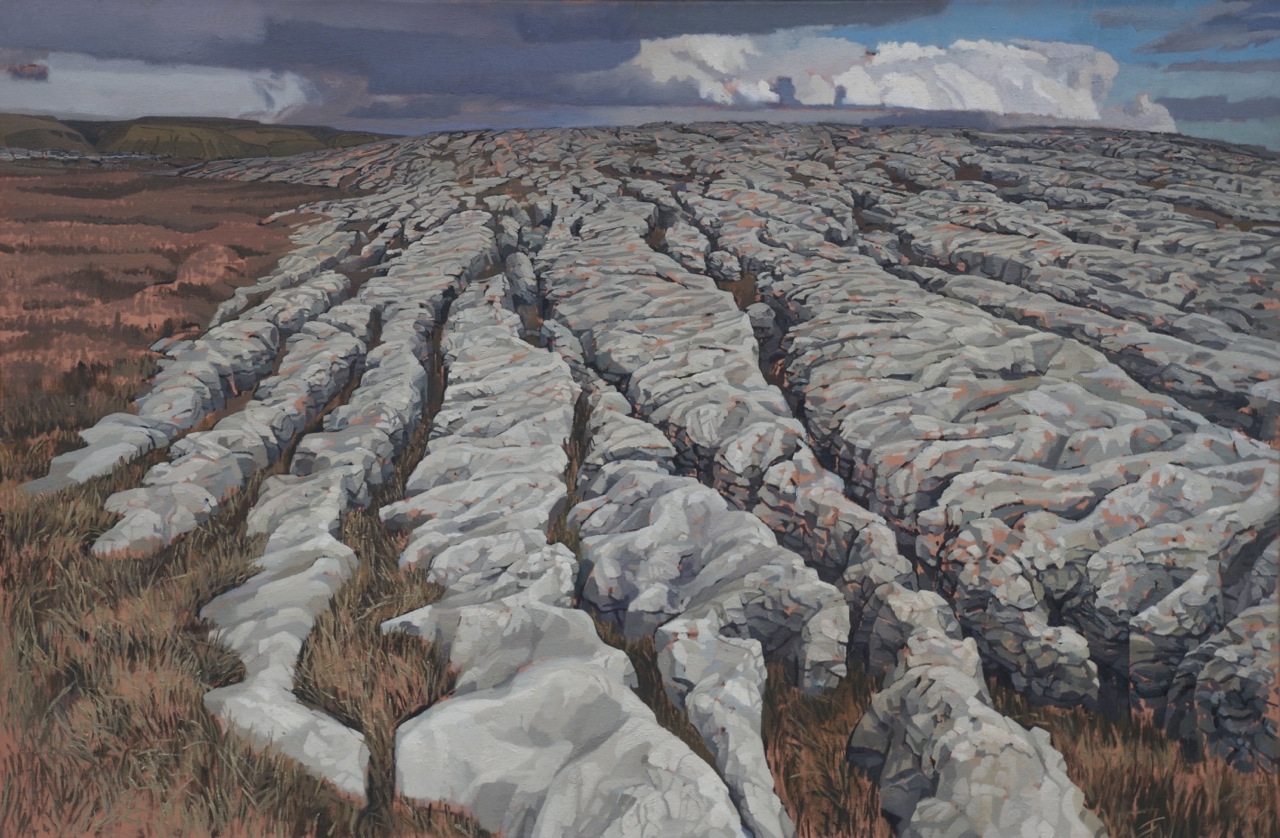
Great Asby Scar I. Oil on canvas, 40 x 60 in. (1016 x 1525 mm.)
The geometry of perspective constructs configurations of points, lines and planes that systematically relate a viewpoint to the vanishing points at infinity for all objects within the field of view. I consider that its mathematical/conceptual idealisation and abstraction is not alien to our sensory experience, but rather that it is consistent with our innate perceptual and cognitive capacities. These capacities constitute a primordial condition for the appearance of objects.
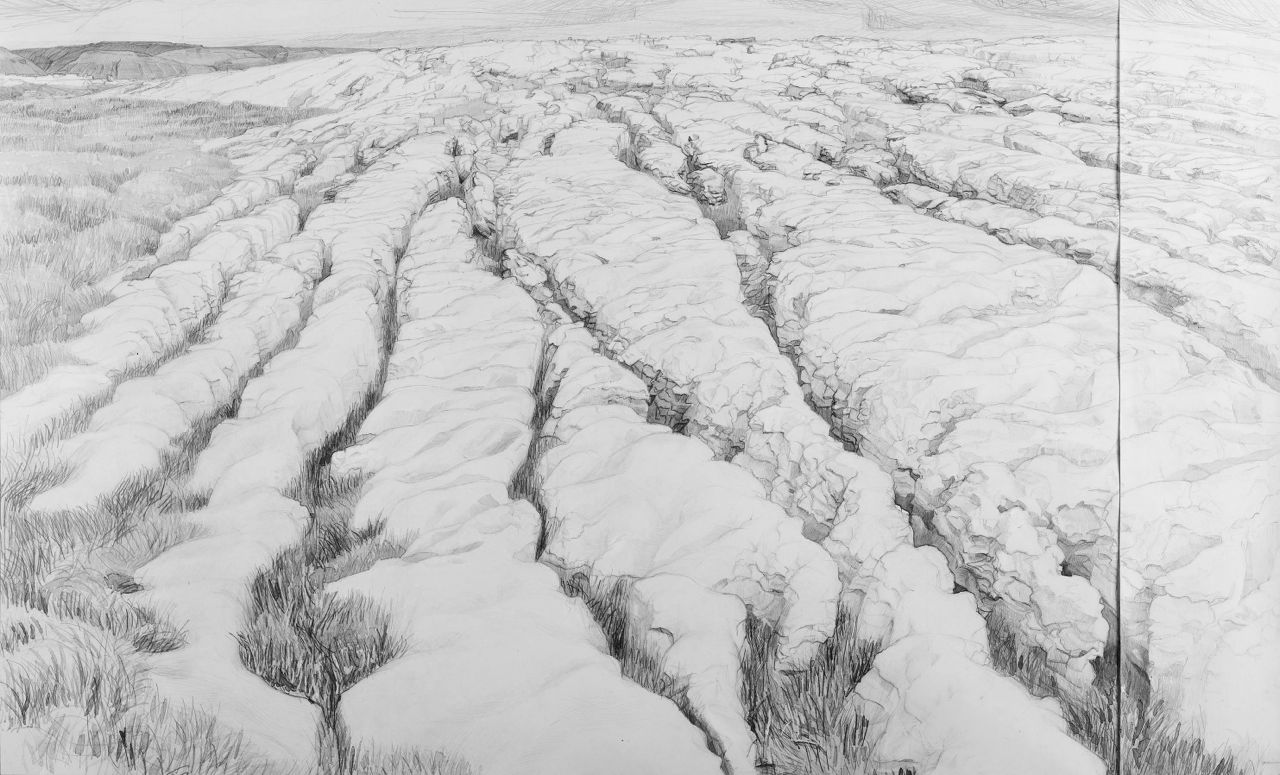
Great Asby Scar I. Graphite and watercolour on paper, 19 1/4 x 31 in. (489 x 788 mm.)
.jpg?timestamp=1462193994075)
Great Asby Scar II. Oil on canvas, 42 x 60 in. (1067 X 1525 mm.)
Clouds
Clouds are numbered among the most oneiric of “poetic things.” ... the reverie of clouds has a peculiar psychological characteristic: it is a reverie without responsibility. (Bachelard [1943] 1988: 185)
Quite often dreamers of clouds see heaps of rocks in cloud-filled skies. The reverse holds true as well. The life of the imagination is one of exchange. ... Here we find ourselves at the centre of the imaginary exchange between clouds and rocks, able at will to make reality imaginary and imagination real. Where metaphors are reversible, the imagination exists in a certain state of grace. ... And thus it seems that, through a sort of dialogue between the rocks and clouds, the heavens come to imitate the earth. (Bachelard [1943] 2002: 142-3)
.jpg?timestamp=1462194193574)
Cumulus Congestus. Oil on canvas 34 x 48 in. (864 x 1220 mm.)
For Percy Bysshe Shelley, clouds were a primordial manifestation of mutability. Like Goethe, Shelley found the developing science of meteorology a major source of poetic inspiration. In the final verse of his poem The Cloud of 1820, Shelley gives vivid expression to the adventures of mutability in the hydrologic cycle:
I am the daughter of Earth and Water,
And the nursling of the Sky;
I pass through the pores of the ocean and shores;
I change, but I cannot die.
For after the rain when with never a stain
The pavilion of Heaven is bare,
And the winds and sunbeams with their convex gleams
Build up the blue dome of air,
I silently laugh at my own cenotaph,
And out of the caverns of rain,
Like a child from the womb, like a ghost from the tomb,
I arise and unbuild it again.
(Shelley The Cloud [1820] 1968: 557-8)
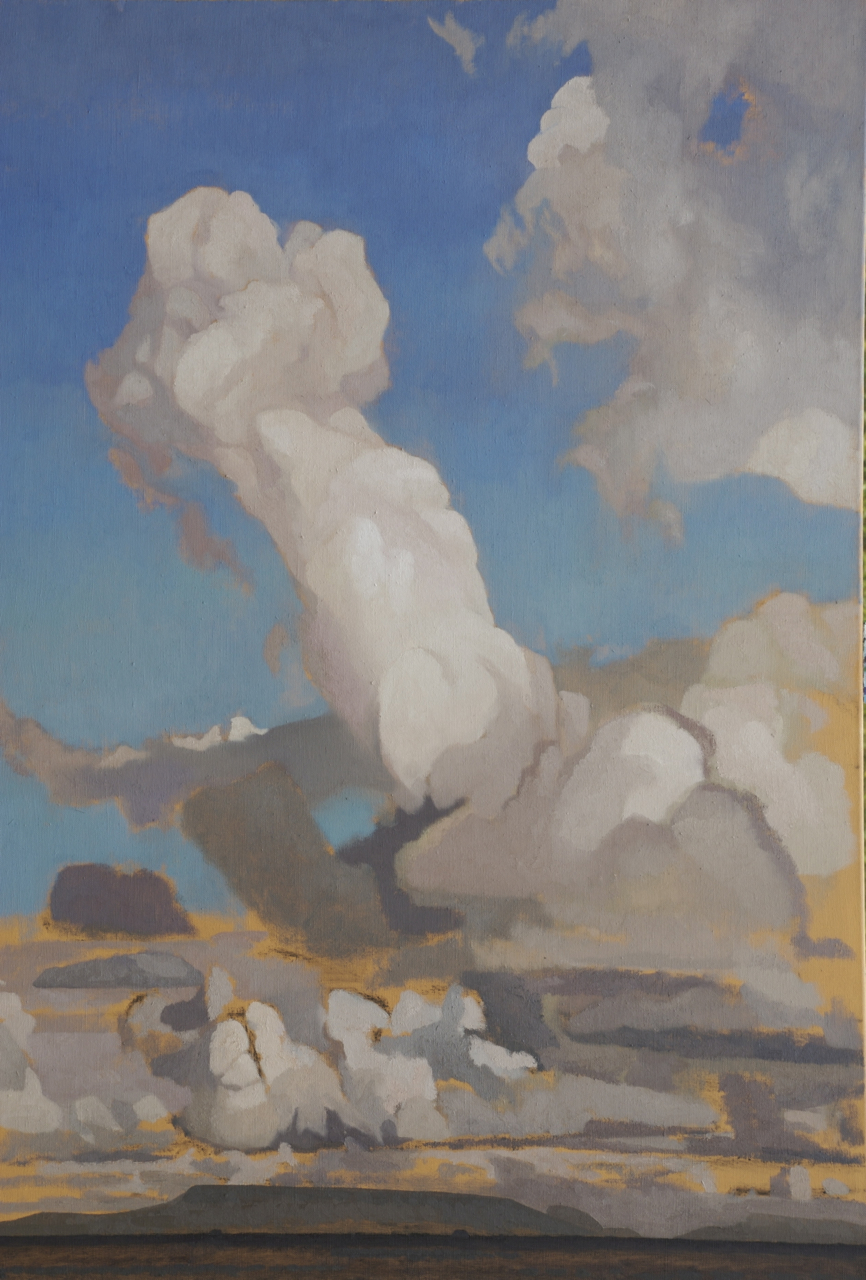
Cumulus Tower. Oil on canvas 48 x 34 in. (1220 x 890 mm.)
Text References:
Arnheim, R. 1954 Art and Visual Perception: A Psychology of the Creative Eye, 1966a edition, Berkeley and Los Angeles: University of California Press.
___ 1966 Toward a Psychology of Art, Berkeley and Los Angeles: University of California Press.
___ [1954] 1974 Art and Visual Perception: A Psychology of the Creative Eye: The New Version, Berkeley and Los Angeles: University of California Press.
Bachelard, G. [1942] 1994 Water and Dreams, Farrell, E. R. (trans.), Dallas: The Pegasus Foundation.
___ [1943] 2002 Earth and Reveries of Will: An Essay on the Imagination of Matter, Haltman, K.( trans.) Dallas: The Dallas Institute Publications.
___ [1943] 1988 Air and Dreams: An Essay on the Imagination of Movement, Farrell, E. R. and Farrell, C. F. (trans.), Dallas: The Dallas Institute Publications.
___ [1958] 1964 The Poetics of Space, Jolas, M. (trans.), Boston: Beacon Press
Cutts, S. 1987 ‘Notes on The Unpainted Landscape’ in Cutts, et al, The Unpainted Landscape, London and Edinburgh: Coracle Press; Graeme Murray Gallery; Scottish Arts Council.
Gablik, S. [1970] 1985 Magritte, London: Thames and Hudson.
Langer, S. 1953 Feeling and Form: A Theory of Art Developed From Philosophy in a New Key, London: Routledge and Kegan Paul.
Shelley, P. B. 1968 Selected Poems, London and Glasgow: Collins.